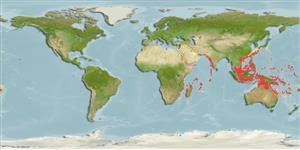Bivalvia |
Cardiida |
Cardiidae
Environment: milieu / climate zone / djupintervall / distribution range
Ekologi
; djupintervall 0 - 37 m (Ref. 104607). Tropical
Indo-Pacific.
Length at first maturity / Size / Weight / Age
Könsmognad: Lm ? range ? - ? cm Max length : 4.2 cm TL hane/ej könsbestämd; (Ref. 2922)
A common littoral species, prefers coral reef and rocky areas with sandy, muddy and rubble substrates (Ref. 104607). Depth estimate based on Family (Ref. 108635).
Life cycle and mating behavior
Könsmognad | Reproduktion | Lek | Eggs | Fecundity | Larvae
Members of the class Bivalvia are mostly gonochoric, some are protandric hermaphrodites. Life cycle: Embryos develop into free-swimming trocophore larvae, succeeded by the bivalve veliger, resembling a miniature clam.
The Academy of Natural Sciences 2006 OBIS Indo-Pacific Molluscan Database. http://data.acnatsci.org/obis/find_mollusk.html [accessed 21/03/2007]. (Ref. 3204)
IUCN Red List Status
(Ref. 130435: Version 2025-1)
CITES status (Ref. 108899)
Not Evaluated
Not Evaluated
Threat to humans
Harmless
Human uses
| FishSource |
Verktyg
Ytterligare information
Trophic EcologyFood items (preys)
Födosammansättning
Födointag
Predatorer
Population dynamicsTillväxtMax. ages / sizesLength-weight rel.Length-length rel.Length-frequenciesMass conversionAbundans PhysiologySyreförbrukning
Human RelatedStamps, coins, misc.
Internet-källor
Estimates based on models
Fishing Vulnerability
Low vulnerability (10 of 100).
